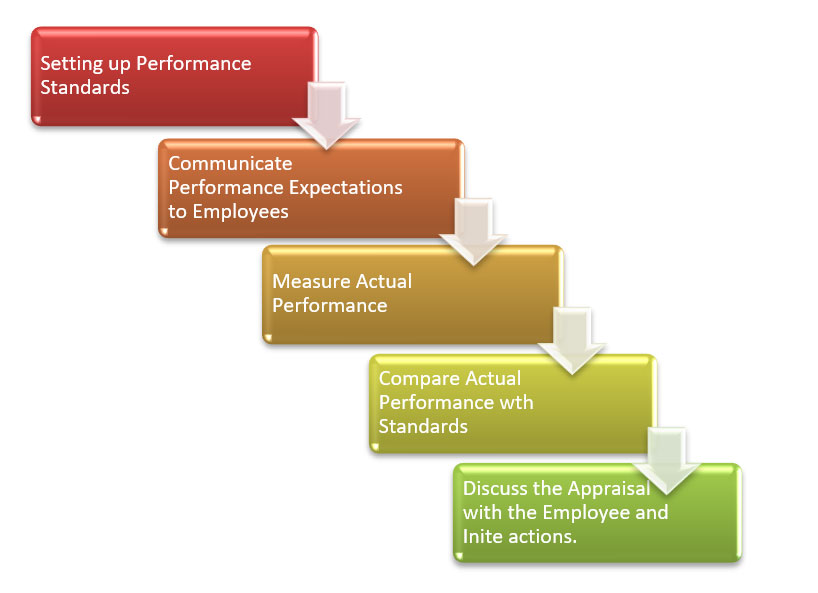Performance Appraisal Process: Step By Step Explanation: To establish the productivity of the employees in an organization, the HRM must ensure that the performance of an employee should be measured on a periodical basis. It is a very significant activity because it is helpful to determine the challenges, as well as weaknesses of the employees and the department, can find better solutions for accurately fixing them. The performance appraisal process is always looked at by all employees.
Performance Appraisal Process: Step By Step Explanation
What do you need to know about Performance Appraisal?
The entire procedure including the evaluation and documentation of the employee’s performance to enhance and improve the quality of work, output as well as efficiency is called as Performance Appraisal. Three vital functions are performed through the process of Performance Appraisal within a company such as providing proper feedback to a person based on a period, identify the needs for development and inform about reviews related to salary and bonus.
Here are some of the steps that may lead to a successful Performance Appraisal which are as given below. Let us put these steps in the limelight.
Also See: Standard Causal Model Of HRM: Definition, Features, Process
- Reflect: The beginning of effective performance appraisal is better as well as an accurate understanding of what the employees want from their job or what their expectations are. To accomplish it, it is vital to know:
- What reasons lie behind the existence of the job;
- Where it suits within the business firm;
- The contribution of the job in overall goals of the organization and present business strategy;
- What will be expected from the employee’s performance as per the behaviour, policies and processes?
- What abilities and knowledge are required?
Moving further, it is also important to look back at the past performance of the employees towards the organizational goal.
- What is the outcome that they produced?
- Their behaviour with the customer, suppliers and other employees of the firm.
- Have they followed all the policies and processes of the company?
- What has been the greatest challenge for them?
- How do they deal with the changes?
- Set Goals: The main focus is on the aspects of the employee’s goals at which they have to work and be better. The ambitions of the employee can also be reflected by the goals for their career. The manager must ensure that the employee’s goal is in direct relation with the priorities as well as strategies of the business. This process needs the involvement of both the manager and the individual to get a better understanding and commitment.
- Feedback: A continuous feedback is a sine qua non of performance appraisal but it does not have to be a part of a scheduled meeting. Most of the best feedback can also get spontaneously in the job at any time. The important thing is that the feedback is vital and also needs to be meaningful. It may also be useful if the feedback is taken through other sources rather than the conventional employee-manager relationship.
- Develop: Through the better understanding of individual tracking next to performance expectations, it will become easy as to what type of education, training and other learn rope opportunities can be prioritized to pave the way towards the goals. The activities of development may include any formal accreditation such as degrees, diplomas and professional certificates or it could be some alternate options like eLearning, research projects and shadowing.
- Review: After every six to twelve months, the manager makes sure to keep a check over the formal review and assess the performance according to the specific goals of the organization.
- Reward: The process of performance appraisal is beneficial for an organization where the reward is given based on an employee’s performance. It can be in the form of an increase in salary, bonus payments and other financial incentives. But it can also be non-monetary rewards such as awards, promotions and improved decision making.
Also See: Competency Mapping: Definition, Process And Needs
The process of Performance Appraisal is conducted by the managers but sometimes it is not done in a particular flow in which it is required to do.
Performance Appraisal Process
A business owner needs to know whether the employees are meeting with the employment standards or not. A process needs to be developed that allows managers to evaluate the performance with the help of goal metrics so that all the issues related to Human Resources and operations must be underlined.
Let us shed light on the step to step guide of proper and accurate Performance Appraisal Process.
- Establish Performance Standards
To begin with, the first and foremost step is to establish the performance standards for employees. It needs to be assessing the outputs, achievements and skills that will be identified. There should be an evolution of standards more than the job analysis as well as job descriptions.
Also See: Dave Ulrich HR Model: Purpose, Strengths, Weakness Explained (2023)
The performance standards ought not to be expressed eloquently like “a good job” or “a full day’s work” as these unclear phrases tell not even a single thing. Standards are the base to set particular criteria for judging the employee’s performance and the level of contribution of each employee to achieve the goals of the organization. All the standards must be understandable easily and should be in measurable terms.
Steps involved in Performance Appraisal

- Communicate Performance Expectations to Employees
Once there is an establishment of the performance standards, then you need to communicate to the concerned employees for which the standards have set up so that they may know what is expecting from them in the future. This may lead to result into appraisal problems if the standards are not properly communicating with the employees.
Also See: MICHIGAN MODEL OF HRM: Diagram, Advantages And Disadvantages
It is observed that normal transference of detailed information from manager to the employees is not a proper communication as it turns into communication when the information has transferred correctly and has been received as well as understood in the same way by the employees.
Through the perfect communication of standards with the employees, the feedback can be obtained. After getting the feedback, amendments will be made in standards if any required or as suggested by the employees. It is undeniable that this communication is a two-way street.
- Measuring the actual performance
This the third step involved in the process of Performance Appraisal. Through this step, the actual performances of an available employee are measured based on various sort of sources such as personal observation, statistical reports, oral reports and written reports.
Needless to say, the feelings of the evaluator should not be swayed the measurement of employee’s performance. The basis of measurement is objective as based upon the facts as well as findings. This is the reason why it is important to keep in mind that more critical thing is what we measure rather than how we measure the same.
Also See: Limitations Of Performance Appraisal System
It is the most difficult task to measure the performance of an employee as it includes also the factors and tasks that have done during the specified time of six to twelve months. The process is not one time as it is done continuously throughout the year to monitor the performance. This stage needs the careful choice of the appropriate type of techniques to evaluate the employee’s performance.
- Compare the Actual performance with Standards
As the performance of the employees is already determined, so it is known as the actual performance. At the very first stage, some standards have established to measure the performance and these standards are used to assess the actual performance of the employee in a specified time. The deviation between the standard performance and the actual performance may divulge through this comparison and help the evaluator to discuss the appraisal with the employee at the next stage.
Also See: Top 12 Duties, Responsibilities And Role of HR Manager
The comparison helps to determine whether the actual performance is less than desired or more than set standards. If the performance is low as per the desired standards, then it signifies a negative deviation in the organizational performance and towards the goals as well. Moreover, it also comprises of recalling, evaluating and analysis of data associated with the employee’s performance.
- Discuss the feedback with employees
The fifth step in the entire process of Performance Appraisal is to provide feedback in front of the employees after evaluating the actual performance with the desired. The step is the most challenging job for the manager to present the correct appraisal to the employees and then properly understand them to accept the performance appraisal in a defined way.
A discussion with the employee one-on-one basis has been done at this stage to keep a check over the strength as well as weaknesses of the employees. This stage has a very impressive impact on future performance. The impact may vary from negative to positive based on an appraisal that how it is presented and discussed.
Also See: 12 Functions of Human Resource Management
All the problems, results, as well as the possible solutions, are discussed to put an end to the consensus. The feedback must be given positively so that it should have a positive impact on the future performance of the employees. The performance appraisal feedback given by the manager is helpful to correct the mistakes and encourage the employees to make more efforts and improve their concentration at the job place.
- Corrective actions must be initiated
Whenever it is required, corrective actions must be initiated which is the final step of performance appraisal. It needs to be identified what areas require more improvement and some valuable measures should be taken to fix the issues that may lead to improve the performance.
Two types of corrective measures are there such as immediate that needed to deal immediately and the other one is basic that dives into the causes of deviations and take time for making adjustments. A sufficient period is required to analyze deviations and then, appropriate actions taken by the managers.
Final thought
The evaluation of performance appraisal is a necessary step for the development of an organization. It is helpful in a vast range of areas such as identifying, fixing and improving that allows an organization to accomplish goals from the human resource point of view. This process is used to transform the weaknesses of employees and not to victimize them. All in all, it is a positive process to enhance the employee’s performance.



